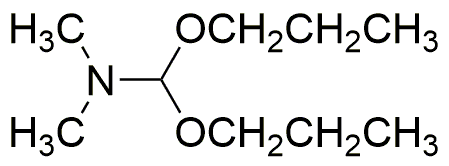N,N-Dimethylformamide dipropyl acetal is widely utilized in research focused on:
- Solvent Applications: This compound serves as an effective solvent in various chemical reactions and processes, particularly in organic synthesis. Its ability to dissolve a wide range of substances makes it valuable in laboratories.
- Polymer Production: It is used in the production of polymers, including coatings and adhesives, due to its excellent compatibility with various monomers. This enhances the performance and durability of the final products.
- Pharmaceutical Development: In the pharmaceutical industry, it acts as a reagent in drug formulation and synthesis, helping to create complex molecules with improved bioavailability and efficacy.
- Textile Industry: The compound is employed in the textile industry for dyeing and finishing processes, providing better color retention and enhanced fabric properties.
- Research and Development: It is frequently used in R&D settings for developing new chemical processes and materials, offering researchers a versatile tool for experimentation and innovation.
General Information
Properties
Safety and Regulations
Applications
N,N-Dimethylformamide dipropyl acetal is widely utilized in research focused on:
- Solvent Applications: This compound serves as an effective solvent in various chemical reactions and processes, particularly in organic synthesis. Its ability to dissolve a wide range of substances makes it valuable in laboratories.
- Polymer Production: It is used in the production of polymers, including coatings and adhesives, due to its excellent compatibility with various monomers. This enhances the performance and durability of the final products.
- Pharmaceutical Development: In the pharmaceutical industry, it acts as a reagent in drug formulation and synthesis, helping to create complex molecules with improved bioavailability and efficacy.
- Textile Industry: The compound is employed in the textile industry for dyeing and finishing processes, providing better color retention and enhanced fabric properties.
- Research and Development: It is frequently used in R&D settings for developing new chemical processes and materials, offering researchers a versatile tool for experimentation and innovation.
Documents
Safety Data Sheets (SDS)
The SDS provides comprehensive safety information on handling, storage, and disposal of the product.
Product Specification (PS)
The PS provides a comprehensive breakdown of the product’s properties, including chemical composition, physical state, purity, and storage requirements. It also details acceptable quality ranges and the product's intended applications.
Certificates of Analysis (COA)
Search for Certificates of Analysis (COA) by entering the products Lot Number. Lot and Batch Numbers can be found on a product’s label following the words ‘Lot’ or ‘Batch’.
Numéro de catalogue
Numéro de lot/série
Certificates Of Origin (COO)
This COO confirms the country where the product was manufactured, and also details the materials and components used in it and whether it is derived from natural, synthetic, or other specific sources. This certificate may be required for customs, trade, and regulatory compliance.
Numéro de catalogue
Numéro de lot/série
Safety Data Sheets (SDS)
The SDS provides comprehensive safety information on handling, storage, and disposal of the product.
DownloadProduct Specification (PS)
The PS provides a comprehensive breakdown of the product’s properties, including chemical composition, physical state, purity, and storage requirements. It also details acceptable quality ranges and the product's intended applications.
DownloadCertificates of Analysis (COA)
Search for Certificates of Analysis (COA) by entering the products Lot Number. Lot and Batch Numbers can be found on a product’s label following the words ‘Lot’ or ‘Batch’.
Numéro de catalogue
Numéro de lot/série
Certificates Of Origin (COO)
This COO confirms the country where the product was manufactured, and also details the materials and components used in it and whether it is derived from natural, synthetic, or other specific sources. This certificate may be required for customs, trade, and regulatory compliance.

